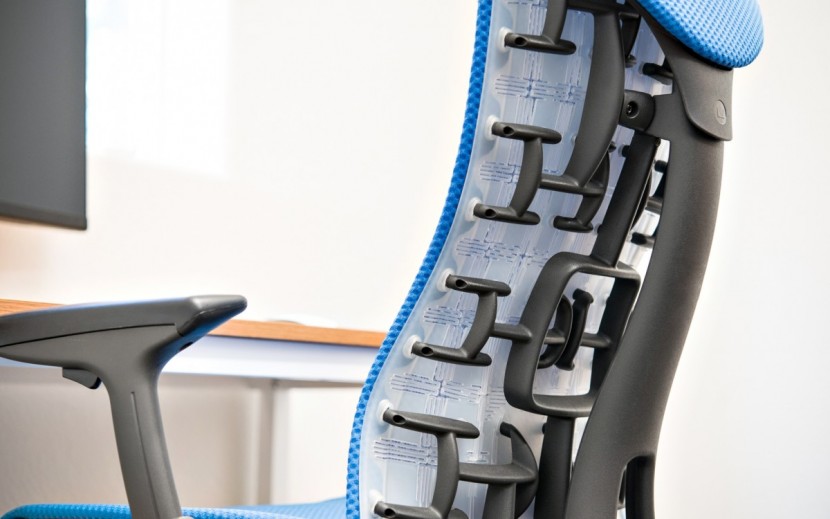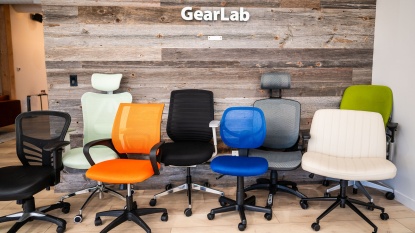Having a hard time picking out a new office chair? While we can't promise that a new chair will alleviate back pain, newer chairs provide much more support and adjustability, allowing you to achieve a much more comfortable and ergonomic sitting position. There is an enormous spread of both features and price when it comes to these products, so you may wonder if it is worth spending $1000 on a chair or if an economy model will do. Keep reading to find out why these expensive models may be worth it for you. We break down the pros and cons and offer a step-by-step process to finding the perfect office chair for your needs and budget. If you are more interested in which model we thought is the absolute best, head on over to our best office chair review to see which seat reigned supreme. If you're seeking a gaming-specific chair, check out our picks for the top gaming chairs.
Step 1: How Much Do You Actually Sit?
The first question that you have to ask yourself when considering a new office chair is how much you are going to sit on the chair on a typical day. For example, if you only sit down at your computer for a few minutes to a half-hour each day to catch up on your email, then it may not be in your best interest to invest in an expensive piece of office furniture.
If you sit for a small portion of the day, you may want to consider upgrading to a more ergonomic chair. Injuries and ailment issues often stem from or can be easily exacerbated by sitting. If you are already struggling with injury or chronic pain, you should probably upgrade to at least a mid-level office chair, which unfortunately comes with a significant price increase. On the other hand, you don't necessarily need to go for a top-of-the-line model if you aren't sitting for a full eight hours a day, five days a week.
If you ARE going to be sitting at your desk for a large portion of your workday, then it is imperative that you get a dedicated office chair, preferably one of the mid to high-end models that offer stellar adjustability and support.
While you initially might be getting sticker shock at the $500 plus price tags of these chairs, there are a few things to keep in mind. First, these higher-end models usually have a much sturdier build quality, allowing them to last for years. A $1000 chair that lasts for a decade seems much more palatable when you think of it as costing $100 a year or less than $8.50 a month.
Spending the money for one of the chairs from the upper echelon can also be a solid investment in your overall health --preventing long-term sitting injuries — and productivity. We tested out some of the cheapest chairs you can purchase — ultimately cutting them from the review before we even finished, as our testers noticed significant discomfort when sitting in them for more than a few hours and a proportional drop in productivity. There is also no direct correlation between price and performance, but you are far more likely to find the support and necessary adjustability to match the chair to your posture with the more expensive models. While these chairs are undeniably expensive, there are some ways to reduce the cost, as you can always find a used model of these chairs in fairly good condition or a factory refurbished model at a decently discounted price.
Now that you have a good idea of what type of chair you should look at, it's time to consider the different types of support these models can offer as well as where your priorities lie.
Step 2: Superior Support?
Take into account your stature. Our tall testers had very different experiences opinions of each of the chairs we tested.
If you are too short for your feet to reach the ground, you can always compensate with a footstool. However, it is easier and more convenient to get a properly sized chair in the first place, rather than having an additional piece of office furniture under your desk.
We looked for chairs with adjustable height and lumbar support. These two features became very important to us throughout our testing period. Take into account how you usually sit — and be honest. Are you a sloucher? If so, make sure you get a chair that encourages good posture but won't be rendered completely uncomfortable if you begin to slouch after your lunch break.
We found mid-back chairs almost universally disliked by our testers and were a sure recipe for causing most of them back pain after a few hours. We also found this to be true for chairs that didn't have adjustable lumbar support. The one-size-fits-all approach does not work to maintain your back's proper S-curve.
We didn't test any chairs that provided less than what we consider the bare minimum, but the level of support across the board varied greatly. We found that the chairs which offer the highest level of adjustability also offer stellar support. In addition to seat height and seat pan depth, a high level of adjustability can be found on many top models. While this setting isn't vitally important, it can be incredibly handy at preventing pressure points and maintaining proper leg circulation. A seat pan too short can create a set of pressure points underneath your thighs and induce discomfort by leaving a large portion of your legs unsupported. A seat pan too deep can apply pressure to the back of your calves, even cutting off circulation and forcing your spine into an awkward position along with the backrest.
One final feature that is found on some top-performing chairs is an adjustable upper back support. In addition to lumbar support, independent upper back support allows you to fully cradle your spine in the proper S-curve and maintain the correct posture on those long days in the office.
Step 3: Angling For Adjustability?
Now, it's time to think about other adjustable features these chairs have that you may be interested in. The two big ones that are immediately worth considering are the reclining capabilities and the armrest adjustability. Adjustability on the armrests is an essential feature that we wouldn't suggest skipping over. All the chairs in our test suite offer height adjustability, as it was a feature we dubbed necessary. Our advanced, and therefore more expensive chairs offer more than just height adjustability for their armrests. The higher-end ones can slide forwards, backward, and even swivel in and out. We love these features, but we wouldn't consider them necessary if you are on a tighter budget.
We are big fans of chairs that have reclining tilt limiters and chairs that can lock into the reclined position. These are not critical features, especially if you are not the type of person who reclines in their office chair all that often, but we love having the option.
Step 4: Functional Or Fashionable Fabric?
Finally, when selecting your perfect office chair, the last thing to consider is what it is upholstered with. While leather and faux leather do have a great boardroom aesthetic, they tend to get a bit sweaty in hot climates, and most offices have air conditioning. Other fabric-covered chairs offer a bit more ventilation but still can get quite sweaty in the hottest condition.
Mesh-backed chairs offer much more ventilation, but the mesh can stretch out over time, degrading the quality of the support if it stretches to the point where you touch the plastic frame.
Rubberized mesh chairs won't stretch out as much and are pretty comfortable but don't look as nice as mesh, leather, or faux-leather chairs. Overall, we would recommend a light to medium-weight fabric, which offers a good mix of breathability and support.
This final choice is largely based on your own personal style preferences. There often isn't a substitute for trying out a chair before you buy, so it is always best to sit in a chair before you get it or at least pick a chair with a good return policy if you don't have the option.
Conclusion
At this point, we hope you feel confident in your quest to find the perfect office chair. Head on over to our side-by-side office chair review to see the best office chairs, or our How We Test article to see exactly how we tested and scored each chair.























